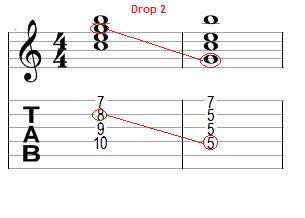Intro to Drop 2 Chords – (Part 1)
In this series on Drop 2 chords we will focus on playing using the top four strings. This is useful for several reasons. Firstly, they are the easiest forms to start playing rather than on other string sets. They produce a clarity in their sound that cuts through a mix as well as staying out of the range of other instruments thus preventing the sound to get too muddy. Also, drop 2 chords and their inversions will allow for better voice leading, creating smooth transitions between chords for a more polished sound. Let’s get started.
One way to play chord voicings on guitar is to play ‘close’ or ‘piano voicings’. But these can be impractical due to large hand stretches necessary to play many of them. Drop 2 voicings solve this problem for the most part by making them easier to play. The term Drop 2 come from taking a close voicing and dropping the pitch of the second highest note from the top of the chord and “dropping’ it down an octave lower. This is shown in Example 1a:

Notice that the second note from the top, G, is moved down one octave in the bass of the chord. The CMaj7 chord is spelled C E G B = 1 3 5 7. When the C is in the bass or the lowest note it is called root position. Since there are four notes in the chord they can be “rearranged” or “inverted” to create voicings where any one of the notes can be played in the bass. They are called inversions. Here are the formulas for all inversions of Drop 2 Major 7 chords. Notice that the R and 5 and the 3 and 7 are always next to each other no matter what inversion is being played.
Root Position – R- 5- 3- 7
1st inversion – 3- 7- R- 5
2nd inversion – 5- R- 3- 7
3rd inversion – 7- 3- 5- R
Here are the four inversions of CMaj7 example 1b:

Practice these forms letting all the notes ring out clearly. A good way to memorize their locations and positions relative to each other is to use the root note (in red) as a guide. Know your roots! Out of all these forms I find the 1st inversion Maj7 to be the most difficult but manageable with some practice.
We’ll stick with key of C to create inversions of chords in a ii-V-I progression. That is a Dm7 -G7-Cmaj7. If you’re not sure what a ii-V-I is, review previous blog posts that nicely explain where it comes from.
Example 1c shows the voicings for Dm7:

Example 1d are the drop 2 voicings for G7:

Now let’s put these together in a ii-V-I or Dmin7-G7-Cmaj7 progression. We will use voice leading principles to create smooth transitions between chords. For our purposes that means finding the chord sets that are the closest together or the smallest movement between chords. For a challenge, use the charts above to try and figure this out on your own. If you’re stuck or if you’re not sure at all use the examples below as a guide. Try playing these in different keys and use them in songs you’re already working on. Have fun!

I especially like the sound of the first example of 1f. It’s a great example of the sound of nice voice leading where some notes stay the same between chords (called common tones) as well as small movements (1/2 step) between other voices (notes) in the chord. With no movement greater than a whole step.
In part two of this series we will expand on this progression by using an easy substitution for the V chord to create an altered b9 sound to spice things up a bit.


